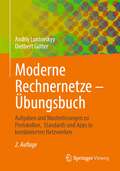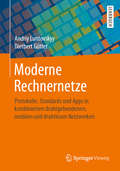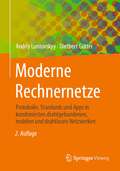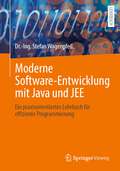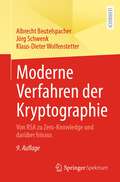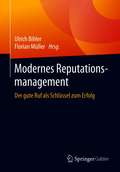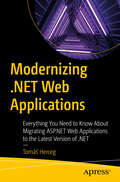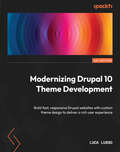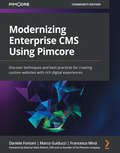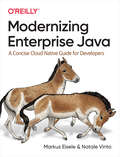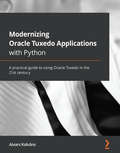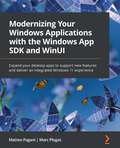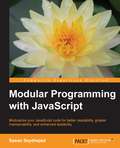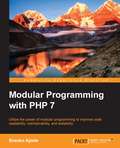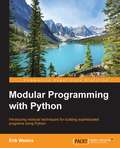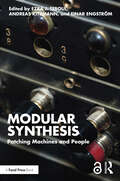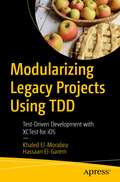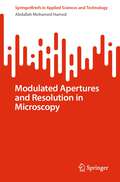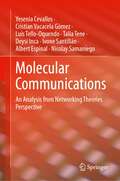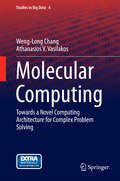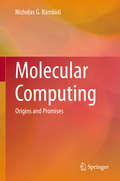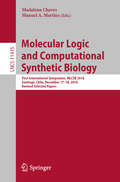- Table View
- List View
Moderne Rechnernetze – Übungsbuch: Aufgaben und Musterlösungen zu Protokollen, Standards und Apps in kombinierten Netzwerken
by Andriy Luntovskyy Dietbert GütterDieses Übungsbuch ergänzt das Lehrbuch "Luntovskyy/Gütter, Moderne Rechnernetze: Protokolle, Standards und Apps in kombinierten drahtgebundenen, mobilen und drahtlosen Netzwerken" um praktische Übungen und dazugehörige Musterlösungen.Die Übungen und Musterlösungen werden den Teilen I, II, III im Lehrbuch zugeordnet und folgen damit dem modularen Aufbau des o.g. Lehrbuchs.Lehrbuch und Übungsbuch eignen sich als vorlesungsbegleitende Literatur zum Modul Computernetzwerke im ET- und IT-Fachstudium für Studierende und Dozenten an technischen Hochschulen.
Moderne Rechnernetze: Protokolle, Standards und Apps in kombinierten drahtgebundenen, mobilen und drahtlosen Netzwerken
by Andriy Luntovskyy Dietbert GütterDas Buch mit einem stark ausgeprägten modularen Aufbau, wird als ein vorlesungsbegleitendes Lehrbuch zum Modul Computernetzwerke im ET- und IT-Fachstudium an technischen Hochschulen empfohlen und enthält drei Teile sowie Zwischenfragen mit dazugehörigen Lösungen und weitere Übungsaufgaben. Teil I beinhaltet eine Einführung in das Gebiet der Rechnernetze. Die weiterführenden Teile II und III behandeln aktuelle Rechnernetztechnologien, Kopplungselemente und Verkabelungskonzepte. Die Leser werden dabei mit verteilten Softwaresystemen und Rechnernetzanwendungen vertraut gemacht.
Moderne Rechnernetze: Protokolle, Standards und Apps in kombinierten drahtgebundenen, mobilen und drahtlosen Netzwerken
by Andriy Luntovskyy Dietbert GütterDas Buch mit einem stark ausgeprägten modularen Aufbau, wird als ein vorlesungsbegleitendes Lehrbuch zum Modul Computernetzwerke im ET- und IT-Fachstudium an technischen Hochschulen empfohlen und enthält drei Teile sowie Zwischenfragen mit dazugehörigen Lösungen und weitere Übungsaufgaben. Teil I beinhaltet eine Einführung in das Gebiet der Rechnernetze. Die weiterführenden Teile II und III behandeln aktuelle Rechnernetztechnologien, Kopplungselemente und Verkabelungskonzepte. Die Leser werden dabei mit verteilten Softwaresystemen und Rechnernetzanwendungen vertraut gemacht.
Moderne Software-Entwicklung mit Java und JEE: Ein praxisorientiertes Lehrbuch für effiziente Programmierung
by Dr.-Ing. Stefan WagenpfeilIn diesem Buch werden die Programmierkonzepte der Sprache Java und der JEE vorgestellt. Eine methodische Abgrenzung zu anderen Programmiersprachen wird durchgeführt, um die Kerneigenschaften von objektorientierter Entwicklung mit Java im Vergleich zu anderen Sprachen herauszuarbeiten. Ein besonderer Fokus liegt auf dem praxistauglichen Einsatz der Konzepte. Daher wird von Beginn an ein starker Projekt- und Realitätsbezug hergestellt, der den Leser*innen konkrete Hilfestellung bietet, um sich in der schnell wachsenden und wechselnden Welt der Softwareentwicklung zurechtzufinden.
Moderne Verfahren der Kryptographie: Von RSA zu Zero-Knowledge und darüber hinaus
by Jörg Schwenk Albrecht Beutelspacher Klaus-Dieter WolfenstetterDie Entwicklung und Analyse von Protokollen wird ein immer wichtigerer Zweig der modernen Kryptologie. Große Berühmtheit erlangt haben die so genannten "Zero-Knowledge-Protokolle", mit denen es gelingt, einen anderen von der Existenz eines Geheimnisses zu überzeugen, ohne ihm das Geringste zu verraten.
Modernes IT-Management: Methodische Kombination von IT-Strategie und IT-Reifegradmodell
by Markus Mangiapane Roman P. BüchlerStrategie und Reifegradmodelle sind zeit- und ressourcenintensiv. Die Autoren legen einen Ansatz vor, der bekannte Modelle umsetzbar macht. Im Zentrum steht der IT-Leistungserbringer, der auf Basis der vier strategischen IT-Perspektiven Geschäftsprozessorientierung, Kundenorientierung, Operationelle Qualität und Zukunftsorientierung bewertet wird. Daraus wird die strategische IT-Ausrichtung abgeleitet.Um den konkreten Handlungsbedarf zu ermitteln, wird der IT-Leistungserbringer mit einem Reifegradmodell beurteilt und der neuen strategischen Ausrichtung gegenübergestellt. Das Vorgehen kombiniert bekannte Schritte zur nachhaltig organisierter Informatik mit hoher Verwertbarkeit in der Praxis.
Modernes Reputationsmanagement: Der gute Ruf als Schlüssel zum Erfolg
by Ulrich Bihler Florian MüllerDieses Buch erklärt, wie modernes Reputationsmanagement von Unternehmen und Organisationen erfolgreich und nachhaltig gestaltet werden kann – insbesondere in volatilen Zeiten des digitalen und gesellschaftlichen Wandels. Emotionale Aspekte und vor allem die Frage, wofür ein Unternehmen steht und eintritt, spielen eine immer wichtigere Rolle – zum Beispiel bei der Kaufentscheidung des Kunden. Die Reputation eines Unternehmens als immaterieller Vermögenswert bestimmt damit maßgeblich den Erfolg und muss bei allen unternehmerischen Herausforderungen professionell, integriert und zielorientiert gemanagt werden. Die Beitragsautoren erläutern grundlegende Funktionsweisen von Unternehmensreputation sowie die Wirkmechanismen von Issues und Public Affairs Management für einen guten Ruf. Sie zeigen auf, wie beispielsweise Predictive Analytics, Purpose, Thought-Leadership-Strategien oder multisensuale Stakeholderkommunikation einen dringend notwendigen Perspektivwechsel herbeiführen und wie Interne Kommunikation sowie CEO-Kommunikation einen ganzheitlichen Reputationsansatz unterstützen können.Ein Buch voller überraschender Perspektiven, neuer Zusammenhänge, interessanter Insights und hilfreicher Praxistipps.
Modernizing .NET Web Applications: Everything You Need to Know About Migrating ASP.NET Web Applications to the Latest Version of .NET
by Tomáš HercegIn 2016, Microsoft introduced the new generation of .NET called .NET Core. It brought many fundamental improvements to the platform, but there were also many breaking changes and missing APIs, especially when it comes to creating web applications. Upgrading any website running on .NET Framework to the new .NET Core proved to be a complex process, which can take months or even years. This book describes two approaches you can take to incrementally modernize legacy .NET web applications. It explains the changes that happened in ASP.NET MVC, ASP.NET Web API, Entity Framework, ASP.NET Identity, SignalR, and other libraries. It also shows a migration path for applications written in ASP.NET Web Forms: a technology which isn’t supported in the new .NET at all. In addition, the book describes the new frameworks available in the ASP.NET Core platform (Blazor, Razor Pages, ASP.NET Core MVC, SignalR Core, and so on) and helps you decide which technology will be the best fit. The book also covers several “soft” areas: how to explain the benefits or necessity for the modernization to your company management, how to deal with refactoring and improving the overall code quality during the entire process, and how to adjust the architecture of the application to be ready for another technology upgrade in the future. The topic of modernization is highly relevant. There are still plenty of legacy .NET applications that are being actively developed and maintained. Many of them were developed for 10+ years, they involve plethora of company-specific know-how, and it is not economically feasible to rewrite them from scratch. What You Will Learn Discover the changes you need to make in a legacy ASP.NET application to migrate it to .NET 8 and beyond Estimate the required effort and prepare the entire process Use the In-place or Side-by-side approach to modernize your application incrementally Migrate from ASP.NET Web Services or WCF to REST or gRPC Migrate from ASP.NET SignalR to SignalR Core or from Entity Framework to EF Core Migrate from Forms Authentication to ASP.NET Identity Migrate ASP.NET Web Forms to Blazor Server or DotVVM Migrate ASP.NET MVC and Web Pages to ASP.NET Core MVC and Razor Pages Refactor and clean up your codebase to make it more maintainable Who This Book Is For .NET developers who work with ASP.NET web applications running on the .NET framework, and tech leads and software architects who make technical decisions about legacy .NET projects used in their organization
Modernizing Drupal 10 Theme Development: Build fast, responsive Drupal websites with custom theme design to deliver a rich user experience
by Luca LussoA comprehensive guide to creating Drupal themes from scratch, from design to fully styled websites with custom Twig templates and headless architectureKey FeaturesExplore real-world examples with proven methodologies to gain a deeper insight into the Drupal theme layerLearn how to translate a graphic design into a maintainable and robust Drupal themeImprove performance and accessibility with a decoupled frontend to consume data exposed by Drupal’s APIsPurchase of the print or Kindle book includes a free PDF eBookBook DescriptionWorking with themes in Drupal can be challenging, given the number of layers and APIs involved. Modernizing Drupal 10 Theme Development helps you explore the new Drupal 10’s theme layer in depth. With a fully implemented Drupal website on the one hand and a set of Storybook components on the other, you’ll begin by learning to create a theme from scratch to match the desired final layout. Once you’ve set up a local environment, you’ll get familiarized with design systems and learn how to map them to the structures of a Drupal website. Next, you’ll bootstrap your new theme and optimize Drupal’s productivity using tools such as webpack, Tailwind CSS, and Browsersync. As you advance, you’ll delve into all the theme layers in a step-by-step way, starting from how Drupal builds an HTML page to where the template files are and how to add custom CSS and JavaScript. You’ll also discover how to leverage all the Drupal APIs to implement robust and maintainable themes without reinventing the wheel, but by following best practices and methodologies. Toward the end, you’ll find out how to build a fully decoupled website using json:api and Next.js. By the end of this book, you’ll be able to confidently build custom Drupal themes to deliver state-of-the-art websites and keep ahead of the competition in the modern frontend world.What you will learnMap design systems made by Storybook components to Drupal structuresUnderstand and use render arrays and Twig templatesGet familiarized with the new Single Directory Component feature introduced in Drupal 10.1Define, import, and use CSS and JavaScript librariesDiscover how to style content created with fields and paragraphsDefine, place, customize, and style blocksExplore advanced topics like extending Twig, making a theme configurable, and boosting performance and accessibilityFind out how to build a decoupled website using json:api and Next.jsWho this book is forIf you are a Drupal backend developer or frontend developer who wants to create Drupal themes that follow industry best practices and are fast and maintainable, this book is for you. Basic knowledge of HTML, CSS, and JavaScript and working knowledge of a CMS are needed to grasp the concepts present in this book.
Modernizing Enterprise CMS Using Pimcore: Discover techniques and best practices for creating custom websites with rich digital experiences
by Daniele Fontani Marco Guiducci Francesco Mina Dietmar Dietz RietschA practical guide to developing, administering, and scaling content management solutions in your organization for supporting digital transformation using PimcoreKey FeaturesKick-start your CMS career by preparing for Pimcore developer certificationsCreate custom websites with a rich digital experience for your business users with the help of step-by-step examplesGet to grips with Pimcore's enterprise features for product management and data managementBook DescriptionUsed by over eighty thousand companies worldwide, Pimcore is the leading open source enterprise-level content management system (CMS) solution. It is an impressive alternative to conventional CMSes and is ideal for creating e-commerce and complex enterprise websites. This book helps developers working with standard CMSes such as WordPress and Drupal to use their knowledge of CMSes to learn Pimcore CMS in a practical way. You'll start by learning what Pimcore is and explore its various services such as PIM, MDM, and DAM. The book then shows you various techniques for developing custom websites in Pimcore based on the scale of your organization. You'll learn how to use Pimcore to improve the digital transformation of a company by implementing enterprise Pimcore features. As you advance, you'll discover Pimcore's capabilities and features that make it a faster and more secure alternative to traditional CMSes. As well as demonstrating practical use cases, Modernizing Enterprise CMS Using Pimcore can help you understand the benefits of using Pimcore as a CMS solution, sharing best practices and proven techniques for designing professional Pimcore sites. By the end of this book, you'll be a trained Pimcore developer, able to create complex websites, and be well-versed in Pimcore's enterprise features such as MDM, PIM, and DAM.What you will learnCreate, edit, and manage Pimcore documents for your web pagesManage web assets in Pimcore using the digital asset management (DAM) featureDiscover how to create layouts, templates, and custom widgets for your web pagesAdminister third-party add-ons for your Pimcore site using the admin UIDiscover practices to use Pimcore as a product information management (PIM) systemExplore Pimcore's master data management (MDM) for enterprise CMS developmentBuild reusable website components and save time using effective tips and tricksWho this book is forThis book is for web developers and CMS professionals looking for an alternative to WordPress and traditional CMS. Enterprise application developers looking for enterprise solutions for digital transformation will find this book useful. Beginner-level knowledge of PHP, HTML, and CSS is needed to understand the code examples used in the book.
Modernizing Enterprise Java: A Concise Cloud Native Guide for Developers
by Markus Eisele Natale VintoWhile containers, microservices, and distributed systems dominate discussions in the tech world, the majority of applications in use today still run monolithic architectures that follow traditional development processes. This practical book helps developers examine long-established Java-based models and demonstrates how to bring these monolithic applications successfully into the future.Relying on their years of experience modernizing applications, authors Markus Eisele and Natale Vinto walk you through the steps necessary to update your organization's Java applications. You'll discover how to dismantle your monolithic application and move to an up-to-date software stack that works across cloud and on-premises installations.Learn cloud native application basics to understand what parts of your organization's Java-based applications and platforms need to migrate and modernizeUnderstand how enterprise Java specifications can help you transition projects and teamsBuild a cloud native platform that supports effective development without falling into buzzword trapsFind a starting point for your migration projects by identifying candidates and staging them through modernization stepsDiscover how to complement a traditional enterprise Java application with components on top of containers and Kubernetes
Modernizing Oracle Tuxedo Applications with Python: A practical guide to using Oracle Tuxedo in the 21st century
by Aivars KalvansLearn Tuxedo by developing solutions in Python for real-world problemsKey FeaturesUnderstand Tuxedo through a modern lens by experimenting with Python codeBoost your productivity by using Python programming to perform common Tuxedo programming tasksManage real-world integration tasks with small Python programsBook DescriptionDespite being developed in the 1980s, Oracle Tuxedo still runs a significant part of critical infrastructure and is not going away any time soon. Modernizing Oracle Tuxedo Applications with Python will help you get to grips with the most important Tuxedo concepts by writing Python code. The book starts with an introduction to Oracle Tuxedo and guides you in installing its latest version and Python bindings for Tuxedo on Linux. You'll then learn how to build your first server and client, configure Tuxedo, and start running an application. As you advance, you'll understand load balancing and work with the BBL server, which is at the heart of a Tuxedo application. This Tuxedo book will also cover Boolean expressions and different ways to export Tuxedo buffers for storage and transmission, before showing you how to implement servers and clients and use the management information base to change the configuration dynamically. Once you've learned how to configure Tuxedo for transactions and control them in application code, you'll discover how to use the store-and-forward functionality to reach destinations and use an Oracle database from a Tuxedo application. By the end of this Oracle Tuxedo book, you'll be able to perform common Tuxedo programming tasks with Python and integrate Tuxedo applications with other parts of modern infrastructure.What you will learnUnderstand Oracle Tuxedo as a microservice platformDevelop Oracle Tuxedo applications using Python 3Perform administration tasks programmatically with Python 3Extract Tuxedo statistics for monitoring application performanceIntegrate Tuxedo into the modern software ecosystemUnderstand how distributed transactions work in TuxedoWho this book is forThis book is for developers who are new to Tuxedo and are looking to develop a new modern front-end or integrate Tuxedo in their applications. The book will also help experienced Tuxedo, C or COBOL developers to improve their productivity and QA engineers to automate Tuxedo application tests. Beginner-level knowledge of Python and Linux shell is required before getting started with this book.
Modernizing Your Windows Applications with the Windows App SDK and WinUI: Expand your desktop apps to support new features and deliver an integrated Windows 11 experience
by Matteo Pagani Marc PlogasUse Windows App SDK and WinUI 3 to take your existing Windows desktop applications to the next level by enabling a modern and accessible UI and integrating the latest Windows features like WinML and Windows HelloKey FeaturesImprove your apps and enable them to support modern devices with features such as touch screens and responsive UIIntegrate your app with the latest Windows innovations using modern tools and the newest C# featuresReuse your existing knowledge in .NET, C#, and Visual Studio to create new Windows appsBook DescriptionIf you're a developer looking to improve and modernize your existing LOB applications to leverage modern Windows features without having to rewrite the entire application from scratch, this book is for you. You'll learn how to modernize your existing Windows Forms, WPF, and UWP applications and enrich them with the latest Windows features.Starting with sample LOB applications that cover common scenarios, you'll learn the differences between various components and then focus on design features for improved visual aspects like accessibility and responsive layouts.The book shows you how to enhance your existing applications using Windows App SDK components and various Windows APIs, resulting in deeper integration with the operating system. You'll be taking a closer look at WinML, which enables Windows applications to evaluate machine learning models offline and leverage the power of your machine, or notifications, to engage with your users in a more effective way. You'll also learn how to make your application deployment-ready by distributing it using various platforms like the Microsoft Store or websites.By the end of this Windows book, you'll be able to create a migration plan for your existing Windows applications and put your knowledge to work by enhancing your application with new features and integrating them with the Windows ecosystem.What you will learnUnderstand the key concepts of the Windows App SDK and WinUIIntegrate new features by creating new applications or by enhancing your existing onesRevamp your app's UI by adopting Fluent Design and new interaction paradigms such as touch and inkingUse notifications to engage with your users more effectivelyIntegrate your app with the Windows ecosystem using the Windows App SDKUse WinML to boost your tasks using artificial intelligenceDeploy your application in LOB and customer-facing scenarios with MSIXWho this book is forThis book is for developers who are building Windows applications with Windows Forms, WPF, and UWP and would like to evolve and modernize their applications, but aren't able to rebuild them from scratch. This book focuses on Line-of-Business scenarios. Basic knowledge of Windows app development, .NET/C#, and Visual Studio will help you understand the concepts covered in this book.
Modernizing the Academic Teaching and Research Environment: Methodologies And Cases In Business Research (Progress in IS)
by Jorge Marx Gómez Sulaiman MouselliThis book constitutes a valuable manual for young and seasoned business researchers alike, and provides a comprehensive summary for the whole research journey. It is a must-read for all researchers who need to understand the basics of business research, from identifying research topics, to planning and organizing the research process, and selecting the most appropriate methodology for the topic at hand. This book also provides insights on how to avoid common pitfalls in business research and outlines the research skills needed to write a fine piece of research. In order to capture the innovative element of research, the book also highlights methods for thinking outside the box. It also stresses the importance of respecting ethics while conducting business research. Lastly, it presents important cases and provides hands-on training for preparing survey tools. Readers looking to master business research won’t want to miss out on this unique and insightful book.
Modular Programming with JavaScript
by Sasan SeydnejadModularize your JavaScript code for better readability, greater maintainability, and enhanced testability About This Book * Design and build fully modular, modern JavaScript applications using modular design concepts * Improve code portability, maintainability, and integrity while creating highly scalable and responsive web applications * Implement your own loosely coupled code blocks that can power highly maintainable and powerful applications in a flexible and highly responsive modular architecture Who This Book Is For If you are an intermediate to advanced JavaScript developer who has experience of writing JavaScript code but probably not in a modular, portable manner, or you are looking to develop enterprise level JavaScript applications, then this book is for you. A basic understanding of JavaScript concepts such as OOP, prototypal inheritance, and closures is expected. What You Will Learn * Understand the important concepts of OOP in JavaScript, such as scope, objects, inheritance, event delegation, and more * Find out how the module design pattern is used in OOP in JavaScript * Design and augment modules using both tight augmentation and loose augmentation * Extend the capabilities of modules by creating sub-modules using techniques such as cloning and inheritance * Move from isolated module pieces to a cohesive, well integrated application modules that can interact and work together without being tightly coupled * See how SandBoxing is used to create a medium for all the modules to talk to each other as well as to the core * Use the concepts of modular application design to handle dependencies and load modules asynchronously * Become familiar with AMD and CommonJS utilities and discover what the future of JavaScript holds for modular programming and architecture In Detail Programming in the modular manner is always encouraged for bigger systems--it is easier to achieve scalability with modular programming. Even JavaScript developers are now interested in building programs in a modular pattern. Modules help people who aren't yet familiar with code to find what they are looking for and also makes it easier for programmers to keep things that are related close together. Designing and implementing applications in a modular manner is highly encouraged and desirable in both simple and enterprise level applications. This book covers some real-life examples of modules and how we can translate that into our world of programming and application design. After getting an overview of JavaScript object-oriented programming (OOP) concepts and their practical usage, you should be able to write your own object definitions using the module pattern. You will then learn to design and augment modules and will explore the concepts of cloning, inheritance, sub-modules, and code extensibility. You will also learn about SandBoxing, application design, and architecture based on modular design concepts. Become familiar with AMD and CommonJS utilities. By the end of the book, you will be able to build spectacular modular applications in JavaScript. Style and approach This in-depth step-by-step guide will teach you modular programming with JavaScript. Starting from the basics, it will cover advanced modular patterns that can be used in sophisticated JavaScript applications.
Modular Programming with PHP 7
by Branko AjzeleUtilize the power of modular programming to improve code readability, maintainability, and testability About This Book * This book demonstrates code reusability and distributed development to get high speed, maintainable, and fast applications * It illustrates the development of a complete modular application developed using PHP7 in detail * This book provides a high-level overview of the Symfony framework, a set of tools and a development methodology that are needed to build a modular web shop application Who This Book Is For This step-by-step guide is divided into two sections. The first section explores all the fundamentals of modular design technique with respect to PHP 7. The latter section demonstrates the practical development of individual modules of a web shop application. What You Will Learn * Discover the new features of PHP 7 that are relevant to modular application development * Write manageable code based on the GoF design patterns and SOLID principles * Define the application requirements of a working modular application * Explore the ins and outs of the Symfony framework * Build a set of modules based on the Symfony framework that comprise a simple web shop app * Use core modules to set the structure and dependencies for other modules to use * Set up entities that are relevant to the module functionality and see how to manage these entities In Detail Modular design techniques help you build readable, manageable, reusable, and more efficient codes. PHP 7, which is a popular open source scripting language, is used to build modular functions for your software. With this book, you will gain a deep insight into the modular programming paradigm and how to achieve modularity in your PHP code. We start with a brief introduction to the new features of PHP 7, some of which open a door to new concepts used in modular development. With design patterns being at the heart of all modular PHP code, you will learn about the GoF design patterns and how to apply them. You will see how to write code that is easy to maintain and extend over time with the help of the SOLID design principles. Throughout the rest of the book, you will build different working modules of a modern web shop application using the Symfony framework, which will give you a deep understanding of modular application development using PHP 7. Style and approach This book is for intermediate-level PHP developers with little to no knowledge of modular programming who want to understand design patterns and principles in order to better utilize the existing frameworks for modular application development.
Modular Programming with Python
by Erik WestraIntroducing modular techniques for building sophisticated programs using Python About This Book * The book would help you develop succinct, expressive programs using modular deign * The book would explain best practices and common idioms through carefully explained and structured examples * It will have broad appeal as far as target audience is concerned and there would be take away for all beginners to Python Who This Book Is For This book is intended for beginner to intermediate level Python programmers who wish to learn how to use modules and packages within their programs. While readers must understand the basics of Python programming, no knowledge of modular programming techniques is required. What You Will Learn * Learn how to use modules and packages to organize your Python code * Understand how to use the import statement to load modules and packages into your program * Use common module patterns such as abstraction and encapsulation to write better programs * Discover how to create self-testing Python packages * Create reusable modules that other programmers can use * Learn how to use GitHub and the Python Package Index to share your code with other people * Make use of modules and packages that others have written * Use modular techniques to build robust systems that can handle complexity and changing requirements over time In Detail Python has evolved over the years and has become the primary choice of developers in various fields. The purpose of this book is to help readers develop readable, reliable, and maintainable programs in Python. Starting with an introduction to the concept of modules and packages, this book shows how you can use these building blocks to organize a complex program into logical parts and make sure those parts are working correctly together. Using clearly written, real-world examples, this book demonstrates how you can use modular techniques to build better programs. A number of common modular programming patterns are covered, including divide-and-conquer, abstraction, encapsulation, wrappers and extensibility. You will also learn how to test your modules and packages, how to prepare your code for sharing with other people, and how to publish your modules and packages on GitHub and the Python Package Index so that other people can use them. Finally, you will learn how to use modular design techniques to be a more effective programmer. Style and approach This book will be simple and straightforward, focusing on imparting learning through a wide array of examples that the readers can put into use as they read through the book. They should not only be able to understand the way modules help in improving development, but they should also be able to improvise on their techniques of writing concise and effective code.
Modular Synthesis: Patching Machines and People
by Andreas Kitzmann Ezra J. Teboul Einar EngströmModular Synthesis: Patching Machines and People brings together scholars, artists, composers, and musical instrument designers in an exploration of modular synthesis, an unusually multifaceted musical instrument that opens up many avenues for exploration and insight, particularly with respect to technological use, practice, and resistance.Through historical, technical, social, aesthetic, and other perspectives, this volume offers a collective reflection on the powerful connections between technology, creativity, culture, and personal agency. Ultimately, this collection is about creativity in a technoscientific world and speaks to issues fundamental to our everyday lives and experiences, by providing insights into the complex relationships between content creators, the technologies they use, and the individuals and communities who design and engage with them.With chapters covering VCV Rack, modular synthesis, instrument design, and the histories of synthesizer technology, as well as interviews with Dave Rossum, Corry Banks, Meng Qi, and Dani Dobkin, among others, Modular Synthesis is recommended reading for advanced undergraduates, researchers, and practitioners of electronic music and music technology. Chapter 3 of this book is freely available as a downloadable Open Access PDF at http://www.taylorfrancis.com under a Creative Commons Attribution-Non Commercial-No Derivatives (CC-BY-NC-ND) 4.0 license.
Modularizing Legacy Projects Using TDD: Test-Driven Development with XCTest for iOS
by Khaled El-Morabea Hassaan El-GaremImprove current or new projects with top notch testability and maintainability. Writing tests improves the design of your apps, as it pushes you to have a more modularized design. This in turn improves the maintainability and sustainability of your apps. This book is for iOS developers who already know the basics of iOS and Swift development but want to learn all the testing pro features in iOS.You'll start by reviewing the TDD Cycle and how to implement these concepts on a legacy project or a new one. You'll then walk through TDD step-by-step on a blank project, including setting up test targets, assertions, and expectations. You'll follow that with all levels of testing such as unit tests, integration tests, and end-to-end tests, and also tackle fairly complex, yet badly written legacy code. The book will take you through the journey of modularizing a legacy app using TDD. Throughout this journey, you will be introduced to multiple testing concepts and techniques, like writing tests for network and core data layers. You will write tests to ensure the thread safety of your app. And you’ll add a new feature while you are in the middle of refactoring, which is an important skill so you can keep adding features while you are fixing your technical debt. By the end of this book, you will have all the tools needed to become a testing master. What You'll LearnUse mocking and dependency injection to make components more testable Write tests for asynchronous code like network code Add new features to existing legacy apps using TDDWho This Book Is ForExperienced iOS developers who care about software quality and meeting customer expectations.
Modulated Apertures and Resolution in Microscopy (SpringerBriefs in Applied Sciences and Technology)
by Abdallah Mohamed HamedThis book serves as a valuable resource for researchers and graduate students specializing in optical engineering and optical sciences. Comprising three distinct parts, it addresses fundamental aspects and practical applications of modulated apertures in microscopy. The first part delves into the fabrication of modulated apertures and the computation of impulse responses or point spread functions (PSFs). It offers essential insights into the foundational concepts of modulated aperture design. The second part focuses on the utilization of modulated apertures in speckle imaging, elucidating their significance and relevance in this context. This section provides a comprehensive understanding of the practical applications of modulated apertures in image formation. The third and final part explores the application of modulated apertures within the framework of a confocal scanning laser microscope. The objective here is to enhance microscope resolution and image contrast, contributing to the advancement of microscopy techniques. This book offers a concise and objective exploration of modulated apertures' fabrication, applications, and their potential to enhance microscopy. This book is a valuable reference for students and researchers seeking to deepen their knowledge in this specialized field.
Molecular Communications: An Analysis from Networking Theories Perspective
by Luis Tello-Oquendo Yesenia Cevallos Cristian Vacacela Gómez Talia Tene Deysi Inca Ivone Santillán Albert Espinal Nicolay SamaniegoThis book provides a complete analysis of molecular communications systems from the paradigm of TCP/IP network stack, and it exploits network theories (e.g. independent functions of a layer into a stack, addressing, flow control, error control, and traffic control) and applies them to biological systems. The authors show how these models can be applied in different areas such as industry, medicine, engineering, biochemistry, biotechnology, computer sciences, and other disciplines. The authors then explain how it is possible to obtain enormous benefits from these practices when applied in medicine, such as enhancing current treatment of diseases and reducing the side effects of drugs and improving the quality of treatment for patients. The authors show how molecular communications systems, in contrast to existing telecommunication paradigms, use molecules as information carriers. They show how sender biological nanomachines (bio-nano machines) encode data on molecules (signal molecules) and release the molecules into the environment. They go on to explain how the molecules then travel through the environment to reach the receiver bio-nano machines, where they biochemically react with the molecules to decipher information. This book is relevant to those studying telecommunications and biomedical students, engineers, masters, PhDs, and researchers.
Molecular Computing
by Athanasios V. Vasilakos Weng-Long ChangThis textbook introduces a concise approach to the design of molecular algorithms for students or researchers who are interested in dealing with complex problems. Through numerous examples and exercises, you will understand the main difference of molecular circuits and traditional digital circuits to manipulate the same problem and you will also learn how to design a molecular algorithm of solving any a problem from start to finish. The book starts with an introduction to computational aspects of digital computers and molecular computing, data representation of molecular computing, molecular operations of molecular computing and number representation of molecular computing and provides many molecular algorithm to construct the parity generator and the parity checker of error-detection codes on digital communication, to encode integers of different formats, single precision and double precision of floating-point numbers, to implement addition and subtraction of unsigned integers, to construct logic operations including NOT, OR, AND, NOR, NAND, Exclusive-OR (XOR) and Exclusive-NOR (XNOR), to implement comparators, shifters, increase, decrease, and to complete two specific operations that are to find the maximum number of "1" and to find the minimum number of "1". The book is also a useful reference source to people new for the field of molecular computing.
Molecular Computing
by Nicholas G. RambidiThe question whether molecular primitives can prove to be real alternatives to contemporary semiconductor means or effective supplements extending greatly possibilities of information technologies is addressed. Molecular primitives and circuitry for information processing devices are also discussed. Investigations in molecular based computing devices were initiated in the early 1970s in the hopes for an increase in the integration level and processing speed. Real progress proved unfeasible into the 1980´s. However, recently, important and promising results were achieved. The elaboration of operational 160-kilobit molecular electronic memory patterned 1011 bits per square centimeter in the end of 90´s were the first timid steps of information processing further development. Subsequent advances beyond these developments are presented and discussed. This work provides useful knowledge to anyone working in molecular based information processing.
Molecular Dynamics Simulations in Statistical Physics: Theory and Applications (Scientific Computation)
by Hiqmet KamberajThis book presents computer simulations using molecular dynamics techniques in statistical physics, with a focus on macromolecular systems. The numerical methods are introduced in the form of computer algorithms and can be implemented in computers using any desired computer programming language, such as Fortran 90, C/C++, and others. The book also explains how some of these numerical methods and their algorithms can be implemented in the existing computer programming software of macromolecular systems, such as the CHARMM program. In addition, it examines a number of advanced concepts of computer simulation techniques used in statistical physics as well as biological and physical systems. Discussing the molecular dynamics approach in detail to enhance readers understanding of the use of this method in statistical physics problems, it also describes the equations of motion in various statistical ensembles to mimic real-world experimental conditions. Intended for graduate students and research scientists working in the field of theoretical and computational biophysics, physics and chemistry, the book can also be used by postgraduate students of other disciplines, such as applied mathematics, computer sciences, and bioinformatics. Further, offering insights into fundamental theory, it as a valuable resource for expert practitioners and programmers and those new to the field.
Molecular Logic and Computational Synthetic Biology: First International Symposium, MLCSB 2018, Santiago, Chile, December 17–18, 2018, Revised Selected Papers (Lecture Notes in Computer Science #11415)
by Madalena Chaves Manuel A. MartinsThis book collects the revised selected proceedings of the First International Symposium in Molecular Logic and Computational Synthetic Biology ( MLCSB), held in Chile, Santiago, in December 2018. The volume contains 7 full revised papers along with 2 surveys from 19 submissions presented at the symposium. One of the goals of the MLCSB 2018 was to explore the potential of molecular logic frameworks to study the emerging behavioural patterns in biological networks, combining discrete, continuous and stochastic features, and resorting both to specific or general-purpose analysis and verification techniques.
